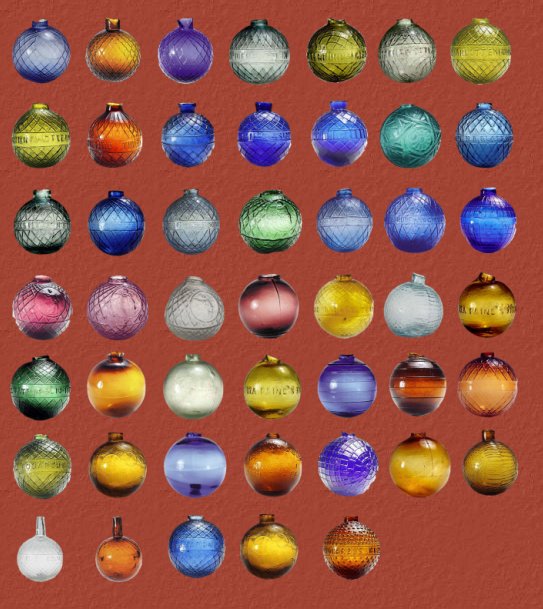For Fun, Sure as Shootin' – Target Balls Hit the Mark
By Alex Kerr
 In more than one area Alex Kerr had made a name for himself; he was widely read as the shotgun editor of Guns and Ammo magazine, his sports equipment store in Hollywood was world famous, he was the son of the founder of Kerr glass, a Hall of Fame skeet shooter (1972) and he had one of the top fruit jar collections in America. and, if you mention the words “target balls” to most collectors, one name comes to mind: Alex Kerr. For an introduction to a unique area of collecting – items made to be destroyed – read on.
In more than one area Alex Kerr had made a name for himself; he was widely read as the shotgun editor of Guns and Ammo magazine, his sports equipment store in Hollywood was world famous, he was the son of the founder of Kerr glass, a Hall of Fame skeet shooter (1972) and he had one of the top fruit jar collections in America. and, if you mention the words “target balls” to most collectors, one name comes to mind: Alex Kerr. For an introduction to a unique area of collecting – items made to be destroyed – read on.
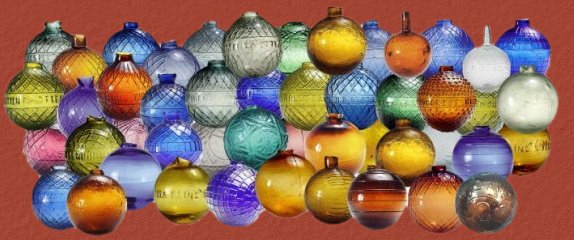
Our earliest competition with shotguns began between the commercial duck hunters who viewed amongst themselves as to who could bring down the most ducks in a single day's shooting.
This form of shotgun competition eventually graduated into “live bird” shooting and our first shooting ranges became established.
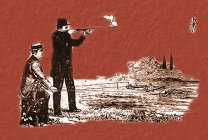 The first animate targets were pigeons, blackbirds, purple martins and bats, and the first records of this type of shooting in America comes from the records of theSportsman Club of Cincinnati during the year 1831.
The first animate targets were pigeons, blackbirds, purple martins and bats, and the first records of this type of shooting in America comes from the records of theSportsman Club of Cincinnati during the year 1831.
 Pigeons eventually became the standard target, as they were available everywhere. Just who originated the idea of trap shooting is unknown, yet most historians credit the English for devising the game in the 1830's.
Pigeons eventually became the standard target, as they were available everywhere. Just who originated the idea of trap shooting is unknown, yet most historians credit the English for devising the game in the 1830's.
In an effort to equalize the type of shots presented to each shooter, the idea of shooting at glass balls was eventually hit upon.
Who started the game of “glass ball” shooting in the United States is not in doubt. Every historian credits Charles Portlock of Boston as introduced or originating the sport in the year 1866. The first competitive shoots began in 1867 in the Boston area.
Unfortunately the game did not have too much success, as the traps used at the time only threw the glass balls straight into the air. Obviously this was not much of a challenge to a shooter who was used to a darting, fast flying pigeon which – when released from its trap – tore off in any direction in order to escape from its temporary prison.
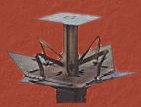
Parker Plunge Trap for release of pigeons.
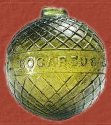 A. H. Bogardus invented the first practical glass ball trap in 1877. This trap threw the ball at least 60 feet through the air in a very long arc.
A. H. Bogardus invented the first practical glass ball trap in 1877. This trap threw the ball at least 60 feet through the air in a very long arc.
 That same year, 1877, Bogardus patented various designs of glass target balls. His early designs for balls included a diamond-shaped pattern surrounding the ball (which he may have copied from the English).
That same year, 1877, Bogardus patented various designs of glass target balls. His early designs for balls included a diamond-shaped pattern surrounding the ball (which he may have copied from the English).
This diamond pattern was raised from the surface of the ball in order to prevent shot from bounding or ricocheting off the edge of the surface of the ball. In most instances any shot hitting one of these ridges would break the ball.
Soon, regulations were drawn up for this type of shooting. The shooter was to be 18 yards back from the traps and the balls had to fly at least 60 feet in the air.
Usually, three traps were used and were hidden from the shooter's view. The left trap threw the ball to the left, the center trap hurtled the ball straight ahead and the right trap threw the ball to the right. The shooter never knew which of three types of shots he would get.
 These early glass balls were much harder to break than the clay pigeons of today. Some companies advertised that their glass balls were made of more uniform thickness than others, therefore they could be made thinner and would break more easily.
These early glass balls were much harder to break than the clay pigeons of today. Some companies advertised that their glass balls were made of more uniform thickness than others, therefore they could be made thinner and would break more easily.
There is no complete record of the manufacturers of these balls. Very few carried the name of their maker and all of these balls were hand blown in molds at the end of a blowpipe.
Glass balls generally may be identified by the neck, which protrudes from each one. The edge of the neck usually is very jagged, caused by breaking away the ball from the end of the blowpipe after the glass had cooled.
Some glass companies advertised their glass balls. Examples are: “Hagerty Bros. 10 Platt St., New York sole manufacturer of Bogardus patent rough glass balls”; “The Bohemian Glass Works, 214 Pear St. Manufacturers of Paines Feather-Filled Glass Ball”; and “Whitall, Tatum and Co. Manufacturer of the Patent Sanded Trap Ball.”
(The Whitall glass plant is still in operation in Millville, N.J., and is owned by this writer's family under the Kerr name.)
These balls were cold packaged in barrels full of sawdust and occasionally full barrels of these are located. Most are found in barns adjoining the areas on which the trap clubs were located.
 Another source comes from the use of these balls as Christmas tree ornaments handed down by several generations in some families.
Another source comes from the use of these balls as Christmas tree ornaments handed down by several generations in some families.
Because of the many companies making these balls, many varieties exist today, and in almost every color imaginable. The most popular of all was amber, which came in shades from a honey color to almost black, depending on how much coloring was added to the glass.
The second most popular color was blue, which also varied from light blue to dark blue.
Bogardus balls apparently were the most popular of the patterned type ball and these exist in both of the colors just mentioned, as well as light to dark green, purple, and a mixture of amber and purple.
Other companies also had innovations, such as their name and address in raised lettering completely around the ball. Others rolled the ball in sand while the glass was still hot enough for the sand to remain embedded in the surface of the ball. Many companies produced cheaper target balls with plain surfaces.
Last but not least were wholesalers of guns and ammunition who had their names embossed on the target balls.
It is difficult to see how the placing of names of manufacturers and distributors on the ball would benefit the producer to any great extent. Just as it is today, it is difficult to determine who the manufacturer of a target would be unless you saw the carton in which the target was contained.
Plain glass balls were usually sold for $1 per hundred and embossed balls at $1.35 per hundred.
Other innovations were patented. Ira Paines (a great shooter in his day) produced a ball known as “Ira Paine's filled ball.” These balls were stuffed with feathers or powder, which gave an illusion of a bird being hit.
When the ball was broken, feathers flew and drifted down to the ground or a puff of dust hung in the air if powder was used.
Two great competitive glass ball shooters emerged from the pack of those who competed in this type of activity. Bogardus received by far the most publicity in this area, primarily through his promotion of the game as well as the advertising of his products.
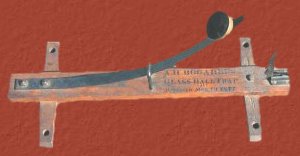
Bogardus Trap, 1877. Displayed in the Trapshooting Hall of Fame Museum.
Bogardus even had a glass ball shooting gallery in Chicago. The gallery apparently handed out souvenir glass balls to the shooters, and carried the following inscription on the base of the ball: “From Bogardus and Co. Shooting Gallery, 158 So. Clark St., Chicago.”
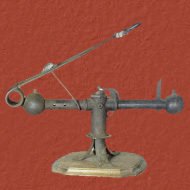
'M. E. Card Patd May 78', American, ca. 1880 - 1900, cast iron construction. This is the earliest of the Card traps, and probably the rarest.
 Last but not least was Bogardus' great shooting ability.
Last but not least was Bogardus' great shooting ability.
At this time Bogardus held about every shooting record in the book. Unlike today, these records were not only for the most number of targets broken out of 100 but the least time taken to break 100 targets as well as breaking the most targets in one day – 4,844 out of 5,000 in 500 minutes!
 Bogardus was by no means a modest man. In 1874 he proceeded to publish a book entitled “Field, Cover and Trapshooting.” Underneath this title were the words “Champion Living Shot of the World.”
Bogardus was by no means a modest man. In 1874 he proceeded to publish a book entitled “Field, Cover and Trapshooting.” Underneath this title were the words “Champion Living Shot of the World.”
In as much as the book was originally published by Forest and Stream magazine we can assume that he had quite a reputation as a live pigeon shooter. The last chapter of his book covers some of his many wins at live pigeon shooting.
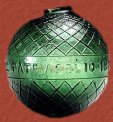 Not satisfied with instructing in the arts of shooting, he later published a book in 1898 entitled “One Thousand Secrets of Rich and Wise Men Revealed,” by C.A. Bogardus, “Champion Shot of the World.”
Not satisfied with instructing in the arts of shooting, he later published a book in 1898 entitled “One Thousand Secrets of Rich and Wise Men Revealed,” by C.A. Bogardus, “Champion Shot of the World.”
The first chapter dealt with his shooting accomplishments, and he goes on to cover many patent medicines and cures he considered to be the best available at the time, as well as what to do in accidents and emergencies, etc.
One thing this man never lacked was belief in himself and confidence in his knowledge of all things.
The other great shooter to emerge in the glass ball era was W.F. “Doc” Carver.
 “Doc” Carver received his nickname as a little boy because he was always trying to heal small birds and animals found in fields surrounding his home.
“Doc” Carver received his nickname as a little boy because he was always trying to heal small birds and animals found in fields surrounding his home.
Unlike Bogardus, he was a very modest man; yet he was considered by some to he the greatest commercial buffalo hunter of all time. In the book “Spirit Gun of the West", he was titled “Plainsman, World's Champion Marksman, Originator of the American Wild West Show.”
It was inevitable that “Doc” Carver and Adam Bogardus would complete against each other, although their face-to-face competition was delayed for years.
Shooting events in those days were conducted in a different manner than matches of today. Challenges were usually issued by either participant or a third party interested in promoting a match. All types of shooting were included in these challenges and large amounts of money were laid on the line.
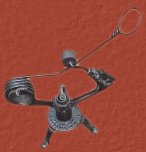
Cast iron three-legged target ball trap embossed: "M. E. CARD, CAZENOVIA, N.Y. U.S.A. and PAT'D MAY 7. 78, APRIL 22, 79 also PATD MAY 8, 82"
Offered were matches such as who could break 100 balls in the shortest period of time, as well as who could break the most balls out of 100 with rifles or shotguns.
Carver and Bogardus first met in competition in a live pigeon match in Louisville in 1883, and Bogardus was beaten by the slim margin of ONE target.
The second and third matches between them were held in St. Louis and Chicago, using clay pigeons. Again, Carver won.
George Ligowsky, the inventor of the clay pigeon and the clay pigeon trap, wished topromote his new invention (patented in 1880) and made an offer too good to be refused by these two shooters.
 The offer consisted of 100 of Ligowsky's targets to be shot on five traps. The shooters were to fire from 18 yards behind the traps and were offered $100 each time either shooter broke 82 or more out of 100. In addition, the winner of each match would receive $300. Each match was to be conducted in one of 25 different cities.
The offer consisted of 100 of Ligowsky's targets to be shot on five traps. The shooters were to fire from 18 yards behind the traps and were offered $100 each time either shooter broke 82 or more out of 100. In addition, the winner of each match would receive $300. Each match was to be conducted in one of 25 different cities.
Bogardus and Carver jumped at the chance and, since each had tremendous confidence in their respective abilities, agreed that they would shoot on a winner-take-all basis!
Carver proceeded to prove that he was by far the better shot of the two by winning all of the matches except six. Bogardus won only three and tied in three others.
Ligowsky accomplished what he wanted, which was the establishment of the clay pigeon as a suitable target that did not leave broken glass lying around.
Clay pigeons, however, did not immediately replace the glass balls, but just added this type of competition to live bird and glass ball shooting.
Clay pigeons did gradually ease glass balls out of the picture in competitive trap shooting. Not so, however, in the Wild West shows. Shattering glass balls was far more spectacular for show business, and balls were manufactured until the 1920's.
Glass target balls were made in England, Canada and the United States. It is possible that some were made in mainland Europe, as “Doc” Carver spent two years in England, France, Austria and Germany shooting against all comers, as well as putting on shooting exhibitions for the Prince of Wales in England, and Emperor William I of Germany.
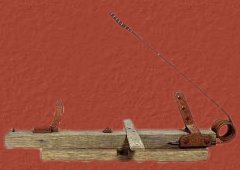
This target ball thrower has no markings but is similar to traps made by Caption Bogardus for his patented glass target balls. The trap swivels on a wooden base, its movement controlled by hand lines attached to the wooden cross piece.
Fortunately, many of these balls have survived to remind us of the early days of competitive shooting.
Alex Kerr was named the “greatest skeet shooter of all time” by the American Shotgunner magazine.
The above story – an in-depth look at the history of target balls – was originally printed in Peterson Publishing Co.'s Guns & Ammo magazine. Some of the photographs above were added.
Target Balls: an Introduction to Items Made to be Broken
By Alex Kerr
Target balls are a form of the glassblower's art that does not under any classification of collecting, as we know it today. They are not bottles of any type yet they were produced in almost the same manner.
I know of no other type of glass articles, which is as difficult to locate. In seeking them out I have ended up with offers of lightning rod balls, Japanese fishing floats, Christmas tree ornaments, witches' balls, dentists alcohol lamps and even a few bottles.
 This situation exists because about 99 percent of those people who have a target ball do not know what it really is.
This situation exists because about 99 percent of those people who have a target ball do not know what it really is.
Fortunately, most of them were attractive enough to be kept. Many ended up where lots of people thought they belonged – on Christmas trees. I have received many throughout the years with hairpins or other pieces of wire inserted into them in order to form necessary loop to use them as a tree decoration.
Trying to research the makers of these items is one of the most difficult tasks of all. A few have patent dates on them, but only a very small amount of these were produce by the patentee. So far I have only uncovered four which have the name of the maker on the ball. As in most cases the patentee was seldom the maker.
1. The manufacturer who had his own patent;
2. A name brand such as Bogardus, who designed his target ball and sold it through sporting goods wholesalers;
3. Glassmakers who sold them directly from there glass plants to wholesalers. Plain target balls fitted mainly into this category;
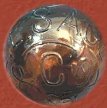 Very seldom did the glassmaker illustrate a glass ball in his ads. However, many ads for these appeared in many sporting magazines of the day. Some of the popular brand names, such as Bogardus and Ira Paine, had their target balls made by several different glassmakers throughout the country as well as some Bogardus balls made in England. So far we only know of three countries that had glassmakers producing target balls: the United States, Canada and England.
Very seldom did the glassmaker illustrate a glass ball in his ads. However, many ads for these appeared in many sporting magazines of the day. Some of the popular brand names, such as Bogardus and Ira Paine, had their target balls made by several different glassmakers throughout the country as well as some Bogardus balls made in England. So far we only know of three countries that had glassmakers producing target balls: the United States, Canada and England.
Many beautiful colors of target balls were made. As these balls were to be thrown into the air to be shot, they had to be easily seen. Very few were made in aqua or clear glass, as they were most difficult to see against the sky. The most popular color was amber, with medium blue following a close second, and purple or amethyst a distant third. In fourth place were various colors of green.
In addition to the above-mentioned colors there were some balls that were almost black, some Vaseline glass and a purple that was almost black.
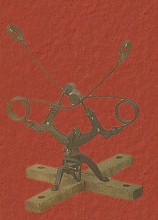
Mole double glass ball trap.
Some of the balls are plain and some have patterns or very high embossing. The idea behind this was to have the ridges of the pattern (the high embossing) to keep the shot from ricocheting off the target ball and not breaking it. Obviously, this type of ball was more expensive to make as the molds were more expensive than molds for plain balls.
Target balls had to be made to do two opposite things:
They had to be strong enough to withstand the impact of starting it through the air at approximately 60 miles an hour and not breaking;
They had to be easily broken when hit by only one small lead pellet.
Target ball collecting, as an investment can be one of the riskiest forms of glass collecting. Unlike bottles and jars, which seem to still pop up here and there, target balls, which may be rare or as yet unheard of, may still be found in large quantities.
In a sense, they were one of the early forms of non returnable bottles, as they were made to be broken. Because of this the only balls kept were those which were picked up off the ground after they were missed or those that were left over from a shooting match and kept in storage.
The use of target balls in competition covered only a few years, as the clay pigeon was perfected within four or five years after target ball shooting became popular.
The main use of target balls after the invention of the clay pigeon was in Wild West shows such as Buffalo Bill's, in which Annie Oakley was the main attraction.
Shoots were often held on farmland near towns, and broken glass littering the ground proved harmful; grazing cattle, sheep and pigs cut their noses when feeding in these areas. Pigs even fed on broken clay pigeons which proved to be poisonous to them.
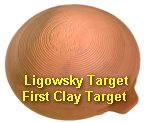 In some locations gun clubs shot over lakes or ponds and many target balls have been recovered by skin divers.
In some locations gun clubs shot over lakes or ponds and many target balls have been recovered by skin divers.
The occasional finding of target balls in large quantities often makes a once comparatively scarce item suddenly available in great quantities, such as from barrels of 100 to 200.
Obviously, when this happens, a scarce target ball becomes more common and less valuable depending on the quantity found. As of this writing, barrels full of plain amber Bogardus and N.B. Glassworks (English) have shown up in this manner.
Fortunately, no one really knows how many target balls exist in their various types and prices range from extremely low to very high, depending on how scarce the ball may be in a dealer's area.
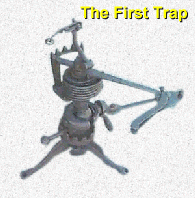
This is the first clay target trap developed by George Ligowsky in 1882.
I have seen them offered for 10 times as much in an area where target ball shooting was non-existent, as in areas where shooting was common
Addendum I
You are probably familiar with trap shooting - the firing with a shotgun at round, clay disks thrown into the air - and perhaps have even done it. But while clay shooting has been around for more than a hundred years, what came before it?
The No. 1 answer is live bird shooting, thousands and thousands of live birds, particularly pigeons (which is why those clay disks are still called "clay pigeons"). But from around 1875 to the early 1900s, glass balls were the target of choice, particularly in exhibition and Wild West Show shooting.
These balls, similar to today's glass Christmas tree ornaments, were very popular, and were shot at across America and Europe. They were the "only substitute ever invented for the living bird," something that Annie Oakley is said to have had silk streamers stuffed inside, something that, in one summer the Bohemian Glass Works was making at the rate of 1,250,000 over six months' time, something Buffalo Bill chased after on horseback, "old ladies" darned socks on and babies allegedly cut their teeth on - all according to an 1878 ad!
In their heyday, target balls sold for a little over a penny each; today one has sold for as much as $14,850, although "common" balls can be found for under a hundred dollars. These glass orbs, once shot at by the hundreds and hundreds of thousands, are now hunted by collectors for their rarity and their link to a colorful era long past.
As a collectible, the diversity of patterns, colors and countries of origin, as well the constantly increasing value, combine to make target balls a hobby that can't miss.
Permission to display glass ball pictures was granted by
ANTIQUE BOTTLE & GLASS COLLECTOR MAGAZINE and
GLASS WORKS AUCTIONS
